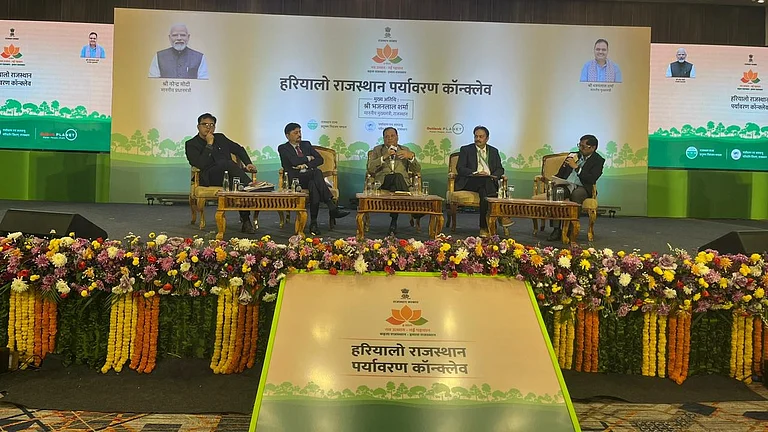In the world of renewable energy, solar is undoubtedly the most prominent buzzword. To ensure that India has a sustainable energy future, it is important that we develop a long-term solar strategy and capacity led by a mix of environmental, economic, and social factors.
India is lucky to have abundant sunlit areas, and is one of the world’s potential leaders for solar energy development. Most parts of India receive 4-7 kWh per square meter per day of solar energy, with around 300 clear and sunny days in a year. India has significant amount of sunlit areas, particularly in states of Gujarat, Punjab and Rajasthan, which can be a perfect setting for large-scale solar power projects. The National Institute of Solar Energy (NISE) has assessed India's total solar energy potential to be about 748 GW (Gigawatts). This estimate is based on covering just 3% of the country's wasteland area with solar PV modules.
But while everyone is talking about adding more solar capacity, very few are asking about how much of that capacity is actually being used. According to the Ministry of New and Renewable Energy (MNRE), India has added over 110 GW of solar capacity till May 2025, including both ground-mounted and rooftop systems. And that poses the big question — how many of these plants are working at their best? All the policy-making and investment decisions have been so much about adding megawatts that no one asks how efficiently they perform. This is where Capacity Utilization Factor (CUF) also known as Plant Load Factor (PLF), comes in.
It is important to understand that a solar power plant, by its nature, cannot operate at 100% of its installed capacity all the time primarily because of the day-night cycle, as it can only generate electricity during daylight hours and that too can be affected by weather conditions like cloud and rain. So, on an average the CUF of Indian solar power plants ranges between 15 and 25% annually, except for regions like Rajasthan which have abundance and quality sunshine where the CUF can go up to 30%. The encouraging part is that these are pretty much the numbers globally as well with some regions in India scoring higher than the global average.
CUF is calculated as the ratio between the actual output from a solar plant and the output if it were running at its rated power for 24 hours. For example, with a 100 MW plant operating at a 19% CUF, it will deliver the equivalent of 19 MW of power on average, which is far less than the rated capacity.
The higher the CUF, the higher the electricity generation from the same plant, the reduced cost per unit, and improved financial health. Lower CUF just means missed returns, inefficient land use, and reduced reliability of clean power. Presently, especially after one or two years of operation, many plants in India face issues maintaining CUF consistently above 19-20%.
Why CUF Must Now Take Center Stage
Electricity demand in the country is rising fast. Global electricity consumption is expected to increase at the fastest pace in years over the 2025-2027 forecast period of this report, fuelled by growing industrial production, rising use of air conditioning, accelerating electrification, and the expansion of data centres worldwide. Global electricity demand rose by 4.3% in 2024 and is forecast to continue to grow at close to 4% out to 2027.
Take the Pradhan Mantri Kisan Urja Suraksha evam Utthaan Mahabhiyan (PM-KUSUM) scheme, launched to promote solar energy in agriculture. Under Component C of this scheme, which focuses on solarising agricultural feeders, the government mandates a minimum CUF of 19% for 25 years. That’s not a stretch goal. It’s the bare minimum to make these systems viable without subsidies.
Anyone working in the field knows the reality concerning degradation, dust, design flaws, and cheap components all drag CUF down over time. Many plants start strong but slip to 16–17% after a few years. That means less energy, lower payouts, and financial strain on developers and DISCOMs alike.
Three Fixes That Can’t Wait Anymore
To truly fix the CUF problem, the industry needs to move past shortcuts and invest in smart, long-term practices.
1. Panel Efficiency is Now the Real Differentiator
Old solar panels offered cell efficiencies of around 17–18%. Today’s higher efficiency TOPCon and HJT panels can push this beyond 22%, with bifacial modules capturing reflected sunlight from the ground. They’re already being used in large-scale utility projects across Gujarat and Rajasthan, with some field trials showing CUF gains of 1.5–2 percentage points purely from better module design.
Yes, some of these modules have a higher upfront cost, but across a 25-year life, they offer better durability, slower degradation, and higher returns, making their long-term economics better.
2. Better Plant Design = Better CUF
CUF doesn’t only depend on panel quality. Plant layout, tilt angles, row spacing, tracker usage, and inverter selection all impact how much sunlight is converted into power.
For instance, solar trackers can boost CUF by up to 20–25% in certain regions, especially where sunlight moves across the horizon for longer periods. Even small tweaks, such as cleaning schedules or layout optimization, can lead to 0.5–1% CUF gains annually.
3. The Tariff Race Has Become a Trap
The solar sector spent the last decade chasing the lowest tariff. However, cutting costs by compromising on design, O&M, or panel quality kills CUF in the long run. A plant built at ₹2.20/unit with poor CUF is worse than one built at ₹2.50/unit with high reliability.
What we need now is a change in thinking. Developers should compete not only on tariffs, but also on guaranteed CUF performance. Investors, lenders, and government agencies must start prioritizing predictable output, not just cheap bids.
India’s solar story can’t be judged by how much we install. It must be judged by how much we deliver. A plant with poor CUF is a liability. If we continue to build weak-performing systems, we will fall short of climate goals and damage trust in this sector.
This is a call for course correction. Developers must stop chasing the lowest tariff at the cost of quality. Investors need to look beyond IRRs and start asking tougher questions about actual energy output. Policymakers must stop celebrating gigawatts and start enforcing performance. If we don't fix this now, we’ll stay stuck with unreliable power, longer coal dependence, and public money wasted on underperforming projects.
About The Author

Mr. Prashant Mathur is the Chief Executive Officer of Saatvik Green Energy Limited. He brings over 20 years of experience in the renewable energy sector. Throughout his career, he has demonstrated strong commercial acumen and a deep understanding of scaling businesses across domestic and international markets. Prior to joining the Company, he held leadership roles at Mundra Solar PV Limited (formerly Adani Solar), Vikram Solar Private Limited, Targray India Private Limited, and Solis Solar Group. Since joining Saatvik Green Energy Limited, Mr. Mathur has spearheaded key strategic initiatives, resulting in exponential sales growth, diversification into new business verticals, and significant operational expansion.





















